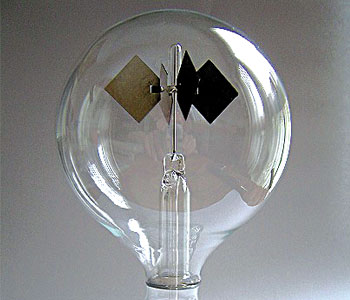Light Touch
The Crookes’ Radiometer: Apply Light Pressure
What did 19th-century scientists know about this fascinating device that many modern physics teachers do not?

I first encountered the Crookes’ radiometer as a child, when I saw a storefront display with a couple dozen of them: light-bulb-shaped things with odd little vanes inside. I had no idea what they were or how they worked, but I was impressed.
Years later, in high school, my physics teacher explained how a radiometer operates. In theory, the spinning vanes were sealed into a bulb from which all air had been evacuated, so that nothing could hinder the rotation of the vanes. Photons impinged on the vanes, which were black on one side and white on the other. The white side had reflecting material on it, and the photon rebounded, transferring twice its initial momentum to the vane. Photons hitting the black side were absorbed, and transferred their momentum just a single time. The vanes thus rotated preferentially away from the white side, with the black side being pushed toward the brightest source of light.
But when I watched a radiometer, I saw that it rotated in precisely the opposite fashion, with the black sides receding from the light source, and the white sides approaching the light. Something was clearly wrong with the explanation. In fact, said my teacher, the real reason for the motive power for the vanes didn’t come from photons at all. The vacuum in the bulb was not perfect, so there was a little residual air. When the light fell on the vanes, the white or mirrored side didn’t absorb any, while the black side absorbed it all and grew hotter.
When air molecules struck the surface, they picked up extra energy and momentum from the hotter black side, so they rebounded more from that side, which in turn rebounded with more momentum than the white side (action and opposite reaction). Thus, the vanes of the radiometer rotated with the black sides going away from the light source, as observed.
What I didn’t know at the time was that this explanation has been known to be incorrect for over a century. Most people don’t realize this, even though there have been several excellent articles pointing it out.
Log in or become a member to view the full text of this article.
This article may be available for purchase via the search at Optica Publishing Group.
Optica Members get the full text of Optics & Photonics News, plus a variety of other member benefits.
